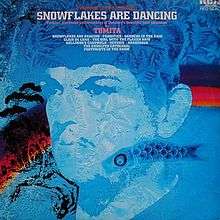Snowflakes Are Dancing
| Snowflakes Are Dancing | ||||
|---|---|---|---|---|
 | ||||
| Studio album by Isao Tomita | ||||
| Released | April 12, 1974 | |||
| Recorded | 1973-4 | |||
| Genre | Ambient, avant-garde, classical, electronic, proto-synthpop | |||
| Length | 41:33 (51:51 in the 2000 CD release) | |||
| Label | RCA Red Seal Records | |||
| Producer | Plasma Music | |||
| Isao Tomita chronology | ||||
| ||||
Snowflakes Are Dancing is the second studio album by Japanese musician Isao Tomita, recorded in 1973-4 and first released as a Quadradisc in April 1974.[1] The album consists entirely of Tomita's arrangements of Claude Debussy's "tone paintings", performed by Tomita on a Moog synthesizer. It entered the top 50 charts in the United States, where it was nominated for four Grammy Awards in 1975, including best classical album of the year, and it was NARM's best-selling classical album of the year.[1][2]
Overview
The use of the term tone paintings here describes the nature of a large portion of Debussy's work which was concerned with mood and colour, eschewing traditional tonality in favour of constructions such as the full-tonal scale, parallel chords, bitonality, and to a certain extent atonality, in order to achieve a greater degree of musical expression not allowed by strict adherence to a single key. Thus, the term tone painting is quite appropriate, in that Debussy's compositions often experimented with a much broader palette of tones, allowing each to behave similar to a colour within an illustration.
The album is considered an early example of proto-synthesizer-pop.[3] It sparked a "revolution in synthesizer programming" which it was responsible for taking to new heights. The album's contributions to electronic music included an ambience resembling a symphony orchestra, the use of reverberation, the use of phasing and flanging to create a spatial audio effect with stereo speakers, electronic surround sound using four speakers, realistic string simulations, portamento whistles, and abstract bell-like sounds created using ring modulation.[4] A particularly significant achievement was its polyphonic sound, which was created without the use of any polyphonic synthesizers (which were not yet commercially released). Tomita created the album's polyphonic sounds by recording selections one part at a time, taking 14 months to produce the album.[5] The modular human whistle sounds used would also be copied in the presets of later electronic instruments.[6]
The track "Arabesque No. 1" was used from 1976 to 2011 as the theme music for the PBS astronomy-based program Jack Horkheimer: Star Hustler (later Jack Horkheimer: Star Gazer);[7] however, its use as the theme was discontinued when the show was revamped as Star Gazers. In Japan during the late 70s, parts of the track "Reverie" were used for the opening and closing of Fuji TV's transmissions.
Track listing
Side A
- "Snowflakes Are Dancing" – 2:10
- "Reverie" – 4:44
- "Gardens in the Rain" – 3:41
- "Clair de lune" – 5:48
- "Arabesque No. 1" – 3:57
Side B
- "The Engulfed Cathedral" – 6:18
- "Passepied" – 3:17
- "The Girl with the Flaxen Hair" – 3:25
- "Golliwog's Cakewalk" – 2:50
- "Footprints in the Snow" – 4:30
Bonus track (2000 CD release)
- 11. "Prelude to the Afternoon of a Faun" – 10:18 (from the 1975 album Firebird)
The title track appears to be a mistranslation back into English of an other-language (probably Japanese) version of Debussy's original title, The Snow Is Dancing (Debussy used English titles for most of pieces in his Children's Corner suite).
Recording Information
The back of the album sleeve displays a complete list of the recording hardware that Tomita used in the creation of the album, including:[8]
- Moog synthesizer
- One 914 extended range fixed filter bank
- Two 904-A voltage-controlled low-pass filters
- One 904-B voltage-controlled high-pass filter
- One 904-C filter coupler
- One 901 Voltage-controlled oscillator
- Three 901-A oscillator controllers
- Nine 901-B oscillators
- Four 911 envelope generators
- One 911-A dual-trigger delay
- Five 902 voltage-controlled amplifiers
- One 912 envelope follower
- One 984 four-channel mixer
- One 960 sequential controller
- Two 961 interfaces
- One 962 sequential switch
- Two 950 keyboard controllers
- One 6401 Bode ring modulator
- Tape recorders
- Mixers
- Two Sony MX-16 8-channel mixers
- Two Sony MX-12 6-channel mixers
- Accessories
References
- 1 2 Billboard magazine, August 16, 1975, p.41.
- ↑ "Isao Tomita". Billboard. Retrieved 2011-05-28.
- ↑ "Snowflakes Are Dancing". Billboard. Retrieved 2011-05-28.
- ↑ Mark Jenkins (2007), Analog synthesizers: from the legacy of Moog to software synthesis, Elsevier, pp. 133–4, ISBN 0-240-52072-6, retrieved 2011-05-27
- ↑ Musician, player and listener, Issue 8, Amordian Press, 1977, p. 40, retrieved 2011-05-28
- ↑ Mark Jenkins (2007), Analog synthesizers: from the legacy of Moog to software synthesis, Elsevier, p. 192, ISBN 0-240-52072-6, retrieved 2011-05-27
- ↑ "Jack Horkheimer Star Gazer FAQ". Jack Horkheimer Star Gazer official site. Miami, Florida: WPBT. October 2007. Archived from the original on February 25, 2008. Retrieved February 19, 2015.
- ↑ Component equipment used by Tomita for this album (Liner notes). Isao Tomita. RCA Red Seal Records. 1976. p. 1.
External links
- Fansite of Isao Tomita
- Tomita – Snowflakes Are Dancing at Discogs (list of releases)
- Snowflakes Are Dancing at MusicBrainz (list of releases)
- Clair De Lune - Ultimate Edition - Isao Tomita on iTunes